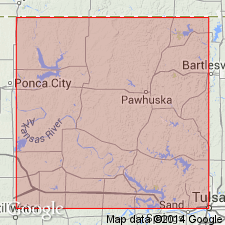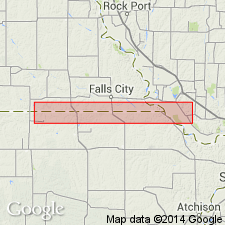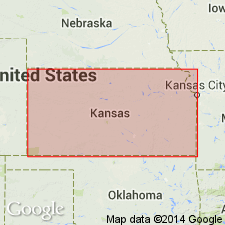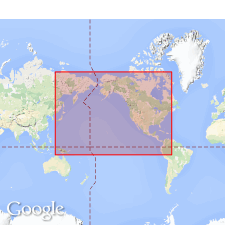
- Usage in publication:
-
- Grayhorse limestone*
- Modifications:
-
- Original reference
- Dominant lithology:
-
- Limestone
- AAPG geologic province:
-
- Chautauqua platform
Summary:
Pg. 138. Grayhorse limestone. Dark brownish gray crystalline conglomeratic limestone, usually 2+/- feet thick but locally 4 feet thick. Contains numerous small pebbles ranging in size from mere grains to that of a large pea, which weather dirty white and give rock a mottled appearance. In most places contains numerous large specimens of MYALINA SUBQUADRATA, some of which are 3 or 4 inches in longest dimension. The outcrops on steep slopes of break off in large slabs as much as 10 feet across which strew the slope below. Is older than Foraker limestone and younger than Stonebreaker limestone. Age is Pennsylvanian.
Named from excellent exposure on crest of Little Grayhorse anticline, in NW/4 sec. 11, T. 24 N., R. 6 E., Osage Co., central northern OK.
Source: US geologic names lexicon (USGS Bull. 896, p. 862-863).

- Usage in publication:
-
- Grayhorse limestone*
- Modifications:
-
- Overview
- AAPG geologic province:
-
- Chautauqua platform
Summary:
Pg. 130. Grayhorse limestone. [The stratigraphic section of rocks exposed in T. 27 N., R. 7 E., Osage County, central northern Oklahoma, shows a thin limestone, called Grayhorse limestone, lying 85 feet below Foraker limestone and 57 feet below a micaceous sandstone. This limestone was named by C.F. Bowen in Bull. 686L, but Heald's chapter in Bull. 686K was released before Bowen's report in Bull. 686L.]
Source: US geologic names lexicon (USGS Bull. 896, p. 862-863).

- Usage in publication:
-
- Grayhorse limestone member*
- Modifications:
-
- Overview
- AAPG geologic province:
-
- Chautauqua platform
Summary:
Grayhorse limestone. Basal member of Sand Creek formation. (See under Sand Creek formation. Also see 1936 entry under Caneyville limestone.) Age is Pennsylvanian.
Source: US geologic names lexicon (USGS Bull. 896, p. 862-863).

- Usage in publication:
-
- Greyhorse limestone member
- Modifications:
-
- Revised
- Areal extent
- AAPG geologic province:
-
- Forest City basin
- Nemaha anticline
Summary:
Pg. 9. Greyhorse limestone member of Pony Creek shale formation of Wabaunsee group. Dark-gray impure limestone, 1 foot thick. Member of Pony Creek shale formation. Overlain by 5 to 6 feet of gray sandy shale forming top member of Pony Creek formation. Underlain by Caneyville shale member of Pony Creek formation. Age is Late Pennsylvanian (Virgil).
[Origin of name not stated.] Present in southeastern Nebraska and northwestern Missouri.
Source: US geologic names lexicon (USGS Bull. 896, p. 879); GNC KS-NE Pennsylvanian Corr. Chart, sheet 2, Oct. 1936.

- Usage in publication:
-
- Grayhorse limestone
- Modifications:
-
- Overview
- AAPG geologic province:
-
- Forest City basin
Summary:
E.C. Reed (Asst. State Geol. Nebraska), 1936 (letter dated Oct. 16). Type locality of Grayhorse limestone in NW/4 sec. 11, T. 24 N., R. 6 E., Osage Reservation, Oklahoma. Due to misprint it is spelled Greyhorse in Paper 8. It should read Grayhorse.
Source: US geologic names lexicon (USGS Bull. 896, p. 879); GNC KS-NE Pennsylvanian Corr. Chart, sheet 1, Oct. 1936.

- Usage in publication:
-
- Grayhorse limestone member
- Modifications:
-
- Overview
- AAPG geologic province:
-
- Cherokee basin
Summary:
Pg. 172. Grayhorse limestone member of Caneyville limestone. Classed as member of Caneyville in eastern Kansas. Overlies unnamed shale; underlies Pony Creek shale. Age is Late Pennsylvanian (Virgilian).
[See also Moore 1936 entry under Caneyville.]
Source: US geologic names lexicon (USGS Bull. 1200, p. 1586-1587).

- Usage in publication:
-
- Grayhorse limestone member*
- Modifications:
-
- Revised
Summary:
Pg. 2273, 2274 (fig. 1). Grayhorse limestone member of Wood Siding formation. Reallocated to Wood Siding formation herein redefined. Overlies Plumb shale member (new); underlies Pony Creek shale member. Age is Late Pennsylvanian (Virgilian).
[GNC remark (ca. 1966, US geologic names lexicon, USGS Bull. 1200, p. 1587): USGS currently classifies the Grayhorse Limestone as a member of the Vanoss Formation in Oklahoma.]
Source: US geologic names lexicon (USGS Bull. 1200, p. 1586-1587).

- Usage in publication:
-
- Grayhorse Limestone Member*
- Modifications:
-
- Overview
- AAPG geologic province:
-
- Chautauqua platform
Summary:
The USGS currently [ca. 1966] classifies the Grayhorse Limestone as a member of the Vanoss Formation in Oklahoma. Age is Late Pennsylvanian (Virgilian).
Source: US geologic names lexicon (USGS Bull. 1200, p. 1586-1587).
For more information, please contact Nancy Stamm, Geologic Names Committee Secretary.
Asterisk (*) indicates published by U.S. Geological Survey authors.
"No current usage" (†) implies that a name has been abandoned or has fallen into disuse. Former usage and, if known, replacement name given in parentheses ( ).
Slash (/) indicates name conflicts with nomenclatural guidelines (CSN, 1933; ACSN, 1961, 1970; NACSN, 1983, 2005, 2021). May be explained within brackets ([ ]).

